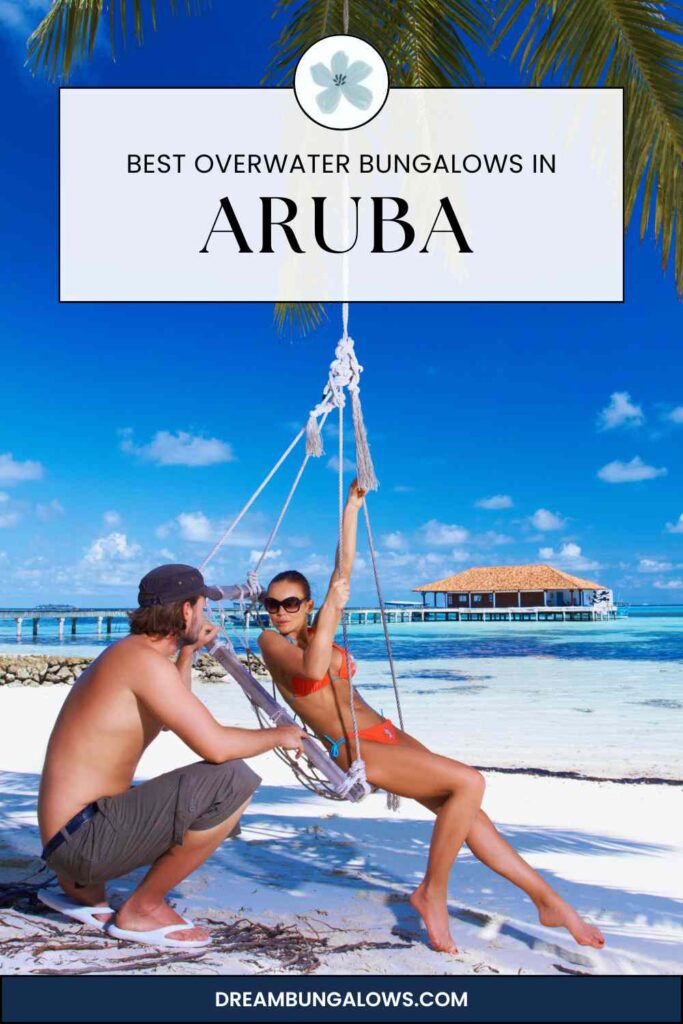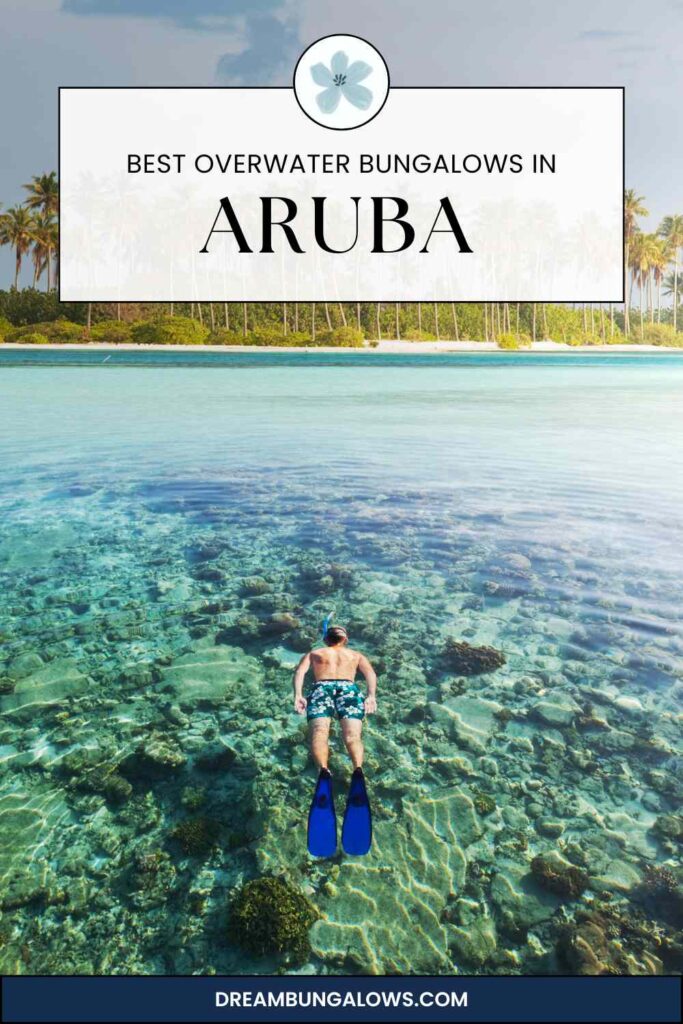Aruba’s sun-kissed shores, steady breezes, and turquoise seas have seduced travelers for decades.
But if you’re eyeing that iconic overwater bungalow fantasy, how does Aruba measure up?
This guide unpacks Aruba’s real overwater villa options, near-water retreats, plus island highlights—ensuring your tropical getaway is brimming with unforgettable memories.
Aruba: One Happy Island Overview
Renowned for its steady sunshine, minimal rainfall, and famously friendly locals, Aruba is a Dutch Caribbean island sitting in the southern part of the region, just north of Venezuela.
Nicknamed “One Happy Island,” Aruba boasts a unique desert-meets-sea landscape—cacti and rugged outcrops inland, and world-class beaches (like Eagle Beach) along its coastline.
English, Dutch, and Papiamento are widely spoken, ensuring easy communication for most visitors. Over two million tourists venture here annually for effortless beach relaxation, vibrant nightlife, shopping, and an all-around carefree vibe.
While you’ll find an abundance of high-rise resorts near Palm Beach and quieter boutique properties around Eagle Beach, the concept of an overwater bungalow in Aruba is less mainstream.
However, one small-scale property has made waves by constructing real stilted villas above the shallow sea—fulfilling that daydream of waking up with fish swimming beneath your floor. Let’s dive deeper.
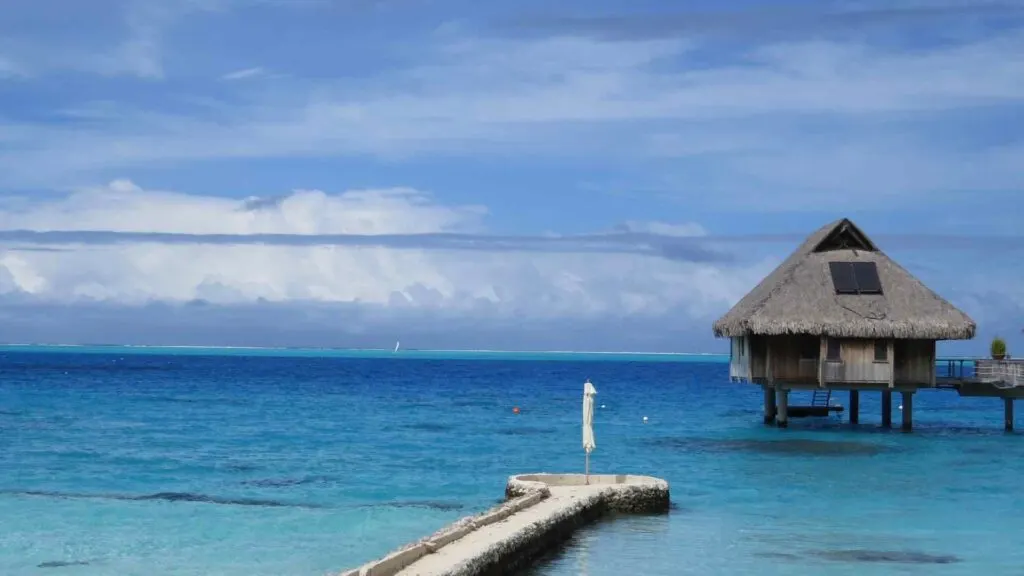
Does Aruba Offer True Overwater Bungalows?
Yes—Aruba Ocean Villas is the primary property in Aruba that provides true overwater accommodations for overnight guests.
Unlike the Bahamas (which lacks full-blown stilt lodging aside from day-use cabanas) or Jamaica (where Sandals leads the charge), Aruba has a single pioneering resort that’s harnessed the island’s calm southwestern waters to build these enticing huts.
However, if you search “Aruba overwater bungalows,” be prepared to weed through marketing claims. Many big chain resorts boast “oceanfront” or “lagoon suites,” but few actually feature stilted lodgings suspended over the water for sleeping.
Aruba Ocean Villas is the real deal—small, intimate, and arguably one of the Caribbean’s best-kept secrets for an overwater experience.
In the next sections, we’ll spotlight what makes it so special, plus highlight near-water alternatives for travelers who might prefer a more traditional beach resort.
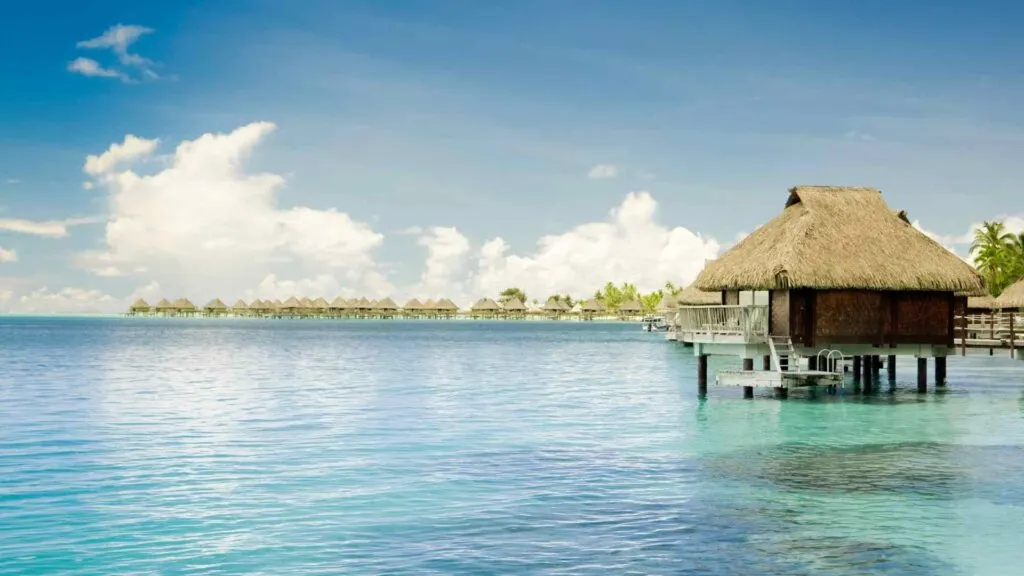
Aruba Ocean Villas: The Real Overwater Gem
Location & Access
- Where: Savaneta, on Aruba’s southwestern coast, about 15-20 minutes south of Queen Beatrix International Airport (AUA).
- Setting: Far from the bustling Palm Beach high-rise area, Savaneta offers a laid-back local vibe. Fishing boats dot the shoreline, and small eateries serve fresh catch-of-the-day.
- Getting There: A private taxi from the airport or any major resort area is easy. Many guests rent a car if they plan to explore beyond Savaneta.
Villa Types & Amenities
Aruba Ocean Villas is boutique, featuring a handful of distinct overwater bungalows (and some beach villas), each with its own flair:
- Overwater Bungalow “LouLou”: Cozy yet luxurious, perfect for couples seeking an intimate hideaway.
- Glass floor panels? In some units.
- Open-air or partially open-air bathrooms with direct sea views.
- Decks with plush seating, maybe a hammock for lazy afternoons.
- More Spacious Villas (“Isabela” or “Sunrise”): Larger footprints, sometimes with a plunge pool or expansive living area. Great for honeymooners or travelers wanting extra space to spread out.
Common threads among them:
- Sea-Facing Decks: With lounge chairs or daybeds for sunbathing, stargazing, or private dining.
- Air-Conditioned Interiors: Many guests worry about heat and humidity—fear not, as most bungalows have AC in the sleeping areas.
- Tropical Decor: Expect a boho-chic or Polynesian-inspired aesthetic, blending local Caribbean style (colorful fabrics, driftwood accents) with thatched roofs reminiscent of the South Pacific.
Why It’s Romantic & Unique
- Privacy: Each bungalow stands apart from the others, offering seclusion. The resort is adults-only, ensuring a tranquil atmosphere devoid of rowdy pool scenes.
- Dine Over the Water: Some packages include romantic dinners served right on your deck, with the breeze whispering through.
- Personal Touches: As a boutique property, staff often greet guests by name and arrange custom experiences—like a private snorkel trip or a vow renewal ceremony at sunset.
Booking Tips & Pricing
- Cost: Overwater bungalows here can range roughly from $600 to $1,200+ per night, depending on season, villa type, and inclusions (breakfast, dinner, etc.).
- Seasonal Demand: High season (December–April) sees rates spike, often selling out months in advance. Summer months are slightly less crowded and cheaper, but watch hurricane-season storms (though Aruba is below the typical hurricane belt, it’s still prudent to consider travel insurance).
- Packages: Some include daily breakfast or a la carte gourmet dining. Others might bundle honeymoon perks (champagne on arrival, couples’ massage, etc.).
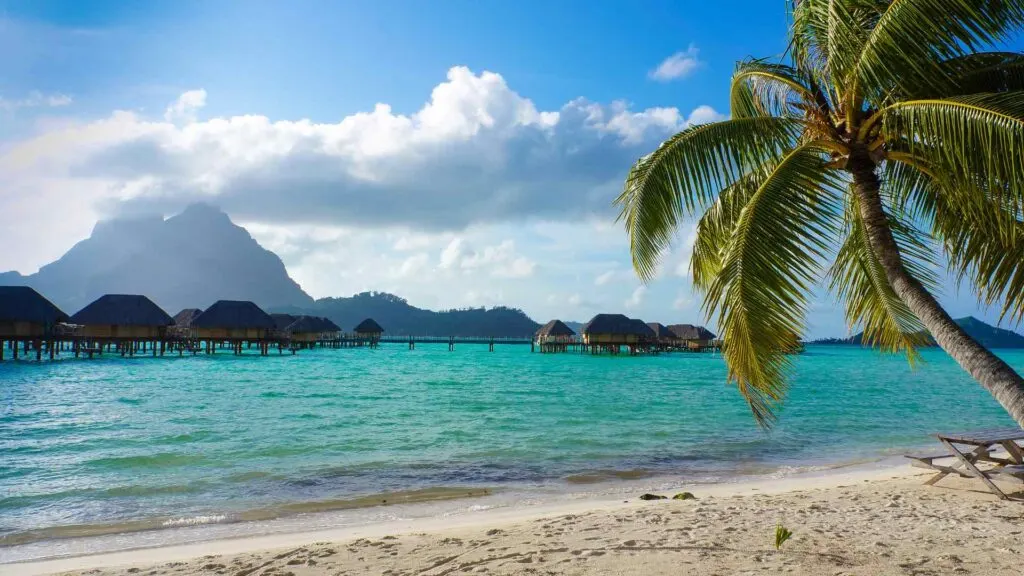
Near-Water Accommodations & Alternatives
While Aruba Ocean Villas stands out as the sole overnight “overwater” option, you can still find lodging that feels like you’re living above the sea—particularly if the villa or suite extends onto a pier or nestles close to the waterline.
Resorts on Eagle Beach & Palm Beach
- Eagle Beach: Widely acclaimed for its serene ambiance and powdery sand, home to low-rise boutique hotels. Properties like Bucuti & Tara Beach Resort or Amsterdam Manor lack stilted huts but deliver pristine ocean views mere steps away.
- Palm Beach: The high-rise hub with names like Hilton Aruba Caribbean Resort, Marriott Stellaris, or Riu Palace—offering more nightlife, dining, and bigger resort amenities. None have overwater bungalows, but many have oceanfront suites with large balconies.
Why Consider These?
- They cater to travelers wanting convenience: multiple on-site restaurants, big pools, and proximity to shops, bars, and casinos.
- Perfect for those who want a lively social scene or prefer a well-established resort brand.
- Some properties do build piers with overwater bars—though not for overnight lodging.
Private Island Day Trips (Renaissance Aruba)
The “Iguana & Flamingo Beach”
- Renaissance Aruba Resort near Oranjestad runs a private island accessible by boat from the hotel lobby. You’ll find the famous flamingo beach, where pink flamingos roam the shore.
- This isn’t an overwater bungalow scenario, but daybeds, cabanas, and waterfront lounge areas can evoke that “above the sea” feeling momentarily.
Pros & Cons
- Pros: A fun day trip if you’re based in central Oranjestad. The pink flamingos alone are Instagram gold.
- Cons: It’s day-use only, and can be crowded. Not the private serenity some overwater fans crave.
Beachfront Villas & Vacation Rentals
- Airbnb & Vrbo: Savaneta, Malmok, or upscale gated communities in Noord sometimes list properties so close to the shore you can practically fish from your deck.
- Why Do It?: Great for families or groups wanting a shared living space, full kitchen, and a cost split among multiple people. Some might have piers or extended decks above the water. Double-check photos—some “waterfront” listings are more rocky coast than sandy beach.
Comparing Aruba Ocean Villas to Other Caribbean Overwater Retreats
Jamaica (Sandals Royal Caribbean & Sandals South Coast)
- Size & Brand: Sandals is a large chain with multiple restaurants, butler service, and all-inclusive packages. Aruba Ocean Villas is boutique, focusing on custom experiences.
- Price Points: Sandals often lands in the $1,500+ per night range for overwater. Aruba’s bungalows might be slightly cheaper, though less all-inclusive in scope.
- Environment: Jamaican resorts can be more lively, with group activities, nightly entertainment. Aruba’s stilt property fosters a quieter, intimate feel.
Mexico (El Dorado Maroma Palafitos)
- All-Inclusive: El Dorado offers gourmet-inclusive dining, numerous pools, and on-site nightlife. Aruba Ocean Villas operates more akin to a small-scale private retreat.
- Accessibility: Cancún is a major air hub with frequent flights. Aruba’s airport is also well-served, but direct flights from certain cities might be fewer.
Belize (Thatch Caye, Cayo Espanto)
- Eco-Focused: Belize’s stilt lodges emphasize rustic-chic vibes, coral reef exploration, and off-grid adventure.
- Which Has Better Beaches?: Aruba’s beaches rank among the Caribbean’s best for calm swimming and wide sandy stretches. Belize is more about cays, mangroves, and barrier reef snorkeling.
Aruba’s main advantage for stilt lodging is:
- A straightforward flight from many U.S. cities
- Iconic beaches, near-constant sunshine, and minimal rainfall
- Dutch-Caribbean flair (a blend of European influences with local island character)
But if you crave an all-inclusive, larger-scale stilt villa environment, places like Sandals or El Dorado Maroma might fit better.
Why Choose Aruba? The Island’s Allure Beyond the Villa
Aruba’s Legendary Beaches
- Eagle Beach: Consistently ranked among the world’s top beaches—known for its wide shoreline, soft powdery sand, gentle waves, and famously photogenic fofoti trees leaning toward the sea.
- Palm Beach: Livelier, lined with high-rise resorts and a boardwalk dotted with bars, restaurants, and nightlife. Water sports like parasailing or jet skiing are readily available.
- Baby Beach: A shallow lagoon on the southeastern tip, perfect for novice snorkelers and families. Calm waters and easy wading define the vibe.
Dining & Culinary Adventures
- Dutch Influences: Sample Dutch pastries, stroopwafels, and local cheese.
- Local Flavors: “Keshi yena” (cheese stuffed with spiced meat), fresh seafood (grouper, wahoo), plantains, and Caribbean jerk-inspired dishes.
- Fine Dining: Upscale restaurants like Elements (at Bucuti & Tara) or Madame Janette offer romantic setups with stellar cuisine.
- Food Truck Scene: Don’t miss spontaneous bites from island-famous trucks—like “Zeerover” in Savaneta for fresh-caught shrimp or fish accompanied by local beer.
Island Excursions & Activities
- Windsurfing & Kitesurfing: Aruba’s constant trade winds transform places like Fisherman’s Huts into wind/kite meccas. Lessons abound for beginners, while advanced riders relish the consistent breeze.
- Jeep Safari to Arikok National Park: See cacti-laced hills, dramatic coastlines, hidden coves, and Indian caves with ancient Arawak drawings.
- Snorkel & Dive: Explore wrecks like the SS Antilla, an impressive WWII-era German freighter. Many reefs ring the island’s southwestern side, teeming with tropical fish, eels, and occasional rays.
- Nightlife & Casinos: Oranjestad and the Palm Beach strip pulse with clubs, bars, and glitzy casinos. Savor local Balashi beer or dance to Aruban carnival beats.
Designing a Honeymoon or Romantic Escape
If overwater romance is your goal, Aruba Ocean Villas remains the prime candidate. But beyond the stilted suite:
- Couples’ Spa Treatments: Book a massage or spa session. Many top resorts or private therapists offer beachside or in-villa services.
- Sunset Catamaran Cruise: Sip champagne while drifting along the coastline at golden hour. Often includes live music or hors d’oeuvres.
- Private Jeep Adventure: Tackle the rugged north coast—watch waves crash at natural bridges, snap selfies at bushy cacti stands, or discover hidden beaches accessible only by 4×4.
- Romantic Beach Dinner: If you’re not staying at an all-inclusive, several restaurants set up candlelit tables on the sand. The wave’s gentle hush and star-drenched sky complete the mood.
- Moonlit Swim: The water near Savaneta can be calm enough for a late-night dip. Some travelers rave about seeing glowing plankton under the moon, an almost magical effect.
Practical Tips for an Aruba Overwater (or Near-Water) Stay
When to Visit & Weather Patterns
- High Season: Mid-December to April sees the lowest rainfall and mild breezes. Hotel prices peak, but the weather is almost guaranteed sunshine.
- Shoulder Season: May–August can offer slightly reduced rates. Aruba sits outside the main Atlantic hurricane belt, so storms are less frequent than other Caribbean spots, but not impossible.
- Temperature: Typically hovers between 80–88°F year-round, with consistent trade winds moderating humidity.
Entry Requirements & Getting There
- Passport: U.S. citizens (and many others) need a valid passport. Check official Aruban immigration for your specific nationality.
- Flight Routes: Queen Beatrix International Airport receives direct flights from multiple U.S. cities (Miami, NYC, Atlanta), Canada, and Europe (Amsterdam).
- ED Card: Aruba has an online embarkation/disembarkation card form. Fill it out pre-trip for a smoother airport experience.
Budgeting & Currency
- Currency: Officially the Aruban Florin (AWG), but U.S. dollars are widely accepted. Credit cards are standard at tourist spots.
- Tipping: Many restaurants add a service charge. Check your bill before tipping extra.
- Prices: Aruba can be on the pricier side—comparable to other upscale Caribbean destinations. All-inclusive deals or booking far in advance can help manage costs.
Transportation on the Island
- Car Rental: Great for exploring the more remote corners (like Arikok or Baby Beach). Driving is on the right-hand side.
- Taxis: Regulated fares, no meters. Confirm price with your driver before setting off.
- Buses: The Arubus system runs between major hotel zones and Oranjestad. Affordable but less frequent for far-flung areas.
Cultural Etiquette & Local Customs
- Languages: Papiamento, Dutch, English, Spanish. Don’t be shy to greet with “Bon dia” (good morning) or “Danki” (thank you in Papiamento).
- Dress Code: Beach attire is fine in tourist zones, but cover up when leaving beaches or entering shops.
- Local Interactions: Arubans are generally welcoming and friendly. Respect for local customs and environment is appreciated—pick up litter, don’t disturb wildlife, etc.
Enhancing Your Overwater Stay: Day Trips & Experiences
Even if you spend nights perched above the sea at Aruba Ocean Villas (or settle for a near-water base elsewhere), the island beckons exploration beyond your deck.
Snorkeling & Diving Hotspots
- Mangel Halto: A short hop from Savaneta, known for calm, shallow waters brimming with fish. Bring your own gear if your resort doesn’t supply it.
- Antilla Wreck: Off Palm Beach, a prime snorkel/dive site at about 60 feet deep, encrusted with corals. Usually accessible via catamaran tours.
- De Palm Island: A tiny islet offering day passes with snorkeling, water slides, and an underwater helmet walk.
Arikok National Park & Off-Road Adventures
- Scenery: Desert-like terrain, jagged coastlines, hidden bays. The park makes up roughly 20% of Aruba’s land area.
- Activities: Jeep tours, ATV rides, or guided hikes let you see Quadiriki Caves, natural pools, and cacti-strewn vistas.
- Wildlife: Aruban whiptail lizards, parakeets, and the elusive Aruban rattlesnake.
Romantic Sunset Cruises
- Often departing from Palm Beach or Oranjestad, these sails whisk you out on catamarans or classic schooners. Many include open bars, small bites, and lively island tunes.
- Perfect for honeymooners or couples celebrating special occasions—some operators do vow renewals at sea.
FAQs: Aruba Overwater Villas & Beyond
Q1: Are Aruba Ocean Villas the only overwater bungalows in Aruba?
Yes, they’re currently the sole resort offering actual stilted huts above the water for overnight lodging. Other accommodations might be oceanfront or close to the shoreline, but not perched over the sea.
Q2: What’s the average cost per night at Aruba Ocean Villas?
Rates fluctuate by villa type and season. Expect roughly $600–$1,200+ per night. Some packages include breakfast or dinner. Prime dates (holidays, winter season) see the highest prices.
Q3: Is it kid-friendly?
Aruba Ocean Villas typically targets adult couples seeking tranquility. Check the property’s age policy if traveling with children.
Q4: Do I need a car if I stay in Savaneta?
If you want freedom to roam beyond your villa—drive to Eagle Beach, explore Arikok, or visit local dining spots—a rental car helps. Otherwise, taxis are an option but can get pricey for repeated trips.
Q5: Does Aruba get hurricanes?
Aruba is located south of the main hurricane belt, so direct hits are rare. However, storms can still bring heavy rains or high winds, especially in late summer/fall.
Q6: Are water sports included at Aruba Ocean Villas?
In some packages, yes—like kayaks or snorkeling gear. The property is smaller than a typical all-inclusive, so inquire about specifics upon booking.
Q7: How far is it from Aruba Ocean Villas to main tourist areas?
Palm Beach is around 25–30 minutes by car. Oranjestad is roughly 15–20 minutes. Savaneta is quieter and more local in flavor.
Q8: Can I do a day visit to Aruba Ocean Villas without staying overnight?
Sometimes they offer day passes or dining reservations for non-guests, but availability is limited. Always call ahead.
Q9: Are there other lesser-known “overwater” structures on Aruba?
A few restaurants/bars might have partial piers or decks, but nothing akin to a fully formed overnight stilted bungalow.
Q10: What’s the difference between Aruba and the Maldives for overwater lodging?
Scale and all-inclusive nature. Maldives resorts typically have large networks of stilt villas with multiple restaurants. Aruba has one small property offering stilt huts, but the island’s broader attractions revolve around beaches, nightlife, and cultural immersion.
Conclusion: Crafting Your Ideal Aruban Getaway
So, does Aruba truly deliver that overwater bungalow fantasy? Yes and no.
For genuine stilted huts perched above the sea, Aruba Ocean Villas stands alone—providing a bohemian-luxe vibe in a serene corner of the island.
However, it’s a boutique gem with only a few units, meaning high demand, so book well in advance.
If your heart yearns for large-scale overwater developments with multiple restaurants, butler service, and pool-laden boardwalks, you won’t find that in Aruba. Instead, consider Jamaica or Mexico for more lavish, all-inclusive stilt experiences.
Still, Aruba competes fiercely on multiple fronts: sugar-white beaches, year-round sunshine, exciting water sports, cosmopolitan dining, and that intangible “One Happy Island” warmth that draws visitors back again and again.
Key Takeaways
- Aruba Ocean Villas is your sole overnight stilt-living option. Perfect for couples seeking a quiet, intimate haven.
- Near-Water Resorts: If you can’t snag a bungalow, enjoy the island’s many beach hotels—some perched at water’s edge for easy dips and sea views.
- Activities Abound: Jeep safaris through Arikok National Park, wreck dives, candlelit beach dinners, flamboyant nightlife, and day outings to places like De Palm Island or Renaissance’s flamingo shore.
- Plan Wisely: Aruba is popular, especially in winter months. Book early, especially for unique stays like overwater villas. Keep an eye on your budget since this can be a premium experience.
- Embrace the Culture: Sample local dishes, vibe with steel-drum or carnival tunes, and greet locals with a friendly “Bon dia.” That personal connection might just become your trip’s cherished memory.
In the end, whether you’re dozing off in a thatched-roof hut above the sea in Savaneta or lounge-hopping along Eagle Beach, Aruba’s luminous waters and carefree spirit make for a brilliant Caribbean escape.
If overwater living is your dream, you can fulfill it with a dash of local authenticity at Aruba Ocean Villas—then let the island’s beaches, breezes, and welcoming smiles complete your tropical reverie.
